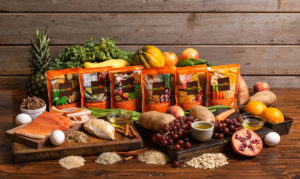
Tube Feeding and Constipation
Preventing and treating one of the most common side effects of tube-feeding
by April Jackson, MS, RD, LDN, CNSC
Talking about bowel habits can be uncomfortable (no pun intended!), but it’s one of the most common side effects of tube-feeding. Nutrition and gut health are closely linked and you can’t really talk about bowel health without discussing the quality of your diet. It’s a fact of tube-feeding life: Regularity is something that many people with feeding tubes struggle with and it can have a direct impact on overall health and quality of life.
What is Classified as Constipation?
Constipation refers to irregularity with the number and frequency of bowel movements. Symptoms include stools that are hard, dry, and difficult to pass and can be associated with straining or pain during passage. In general, if you’re having less than 3 bowel movements per week or going more than 3 days without a bowel movement, you should discuss constipation with your medical provider.
What Causes Constipation?
In general, there are a number of causes of constipation, many of which come into play when someone with a feeding tube is fed a formula-only diet:
 1. Changes in diet. People with feeding tubes often experience a massive dietary change when going from a typical oral-eating diet to solely relying on a tube feeding formula. Many of these formulas rely on highly processed ingredients, which have been shown to lead to inflammation in the body and chronic diseases.1 2 Although infants and children who have only been formula fed may not have a sudden change in their diet, the lack of variety and progression to real food may factor into constipation issues as well. Formula-only diets lack vegetables, fruits, and whole grains – all things that would generally be encouraged to an oral-eater dealing with constipation.
1. Changes in diet. People with feeding tubes often experience a massive dietary change when going from a typical oral-eating diet to solely relying on a tube feeding formula. Many of these formulas rely on highly processed ingredients, which have been shown to lead to inflammation in the body and chronic diseases.1 2 Although infants and children who have only been formula fed may not have a sudden change in their diet, the lack of variety and progression to real food may factor into constipation issues as well. Formula-only diets lack vegetables, fruits, and whole grains – all things that would generally be encouraged to an oral-eater dealing with constipation.
2. Low fiber intake. Fiber adds bulk to stool and absorbs water from the intestines, making stools softer and easier to pass. Diets low in fiber reduce the amount of undigested food in the intestines, which leads to less stool output. Many conventional tube feeding formulas do not contain fiber or the fiber content varies greatly in type and amount. While commercial formulas with added (processed or synthetic) fiber are available, they have been shown to provide little help in treating constipation for most individuals, they increase the risk of clogging the feeding tube, and they may decrease the absorption of certain medications.3 4
3. Dehydration. Adequate fluid intake is important in maintaining regularity whether you are drinking by mouth or through your feeding tube. Fluid needs vary based on age, weight, gender, activity level, and even what climate you live in. One of the best ways to check for dehydration is urine color. The goal should be pale yellow urine.
4. Physical Limitations Decreased activity can slow down the movement of stool through the colon and causes an incomplete emptying of the bowels. This gives the body more time to absorb water out of the stool, leading to constipation. People who are bedridden or immobile typically eat less because they aren’t burning calories through activity. This also leads to longer times between bowel movements, which can also lead to constipation. People with low muscle tone, neuromuscular problems, and/or developmental delays are especially at risk of constipation.
5. Medications and supplements. Several types of medications and supplements can cause constipation. Some, like those containing aluminum and calcium, may interfere with important muscle contractions in the gut. Certain medications used to treat epilepsy, muscle spasms, and pain can also impact these muscle contractions by sending mixed signals to the gut. Diuretics can lead to dehydration (which we know is another cause of constipation). When it comes to supplements, synthetic forms of iron and zinc can lead to or exacerbate constipation, and are added to every tube-feeding formula on the market.5 [Note: Real Food Blends meals have no synthetic vitamins or minerals.]
Preventing and Relieving Constipation
If an oral-eating person complained to their doctor or medical team about constipation issues, the first questions would be: “Are you eating enough fruits and vegetables? Whole grains? Getting enough water?” Before considering adding medications for constipation, people with feeding tubes should first look at their nutrition and hydration.

Think Food First. There are a whole host of benefits from incorporating real food into your tube feeding diet. Research shows that blenderized diets can improve common GI intolerance symptoms associated with commercial formula use, including decreasing nausea and vomiting, diarrhea, reflux and constipation.2 6 7 Soluble and insoluble fibers from fruits, veggies, and whole grains have been shown to improve constipation and diarrhea in people with feeding tubes.6 2 The recommended daily intake for fiber is 14 grams per 1000 calories, which is about 25 grams per day for most women and 38 grams per day for men.1 [Each Real Food Blends meal contains 2-6 g of fiber and includes a fruit, vegetable, and whole grain or healthy starch.] Aside from the numeric fiber goals, remember that fiber quality matters! The synthetic or processed fibers added to most tube-feeding formulas may not be handled in the body the same way as the fibers from the whole foods. Just because you may be hitting a daily fiber goal from formula shouldn’t rule out that fiber still might be a contributing to constipation.
Real food can also help with constipation caused by synthetic iron supplements commonly added to formula–iron from whole food sources is generally better tolerated and results in less GI discomfort. Iron from red meat, poultry, and fish is well absorbed by the body and combining those with foods rich in vitamin C (like orange juice, kale, spinach, and sweet potatoes) increases the absorption of iron even more. [Each Real Food Blends meals contains a high quality lean protein and vitamin C rich fruits or veggies.]
Hydrate. Additional fluids are recommended with tube feedings and especially with blenderized diets, just like oral eaters are encouraged to drink eight 8 ounce glasses of water per day. These fluids can be given as additional flushes before, after, and in between feedings. [Consult your medical team for fluid recommendation for your specific needs.] Water is the typical fluid of choice, and flushing with warm liquids may help stimulate a bowel movement. (Concerned about volume intolerance? Learn more about free water and volume tolerance here.)
Using juice as an additional fluid can also help with constipation. Juices contain sorbitol, a sugar alcohol known for its natural laxative effects, and soluble fiber, which provide a fuel source for good bacteria in the gut. Prune, cherry, pear, and apple juice in particular contain high levels of sorbitol. A good starting point is flushing with 4-8 oz of prune juice daily (2-4 oz for kids) if you are experiencing constipation.8
Get moving. Increasing activity helps to speed up the movement of food through the intestines. This means that there is less time for the body to absorb fluid from the stool, making it easier to pass. Although some people with feeding tubes may be limited in the physical activity they are able to do, the Physical Guidelines for Americans state that “some physical activity is better than none, and adults who participate in any amount of physical activity gain some health benefits.”9 Consult your medical provider before starting any exercise program.
Add probiotics. Probiotics are live microorganisms that improve overall gut health. They are found in cultured or fermented foods like yogurt, kefir, cottage cheese, sauerkraut, kombucha, pickled vegetables, kimchi, miso, and tempeh. Studies suggest that L. acidophilus and B. bifidum may improve intestinal motility and relieve constipation by reducing the pH of the gut.10 Adding pourable kefir, yogurt, or cottage cheese to your tube feeding diet is an easy way to incorporate added probiotics.
This blog is not intended to be medical advice. Always consult your medical team before making any changes in your tube feeding diet.
Sources
1 U.S. Department of Health and Human Services and U.S. Department of Agriculture. 2015-2020 Dietary Guidelines for Americans. 8th ed. 2015. http://health.gov/dietaryguidelines/2015/guidelines/
2 Hron B, Fishman E, Lurie M, Clarke T, Chin Z, et al. Health Outcomes and Quality of Life Indicies of Children Receiving Blenderized Feeds via Enteral Tube. J of Peds 2019;1-7
3 Malone AM. Enteral formulations. In: Cresci GA, ed. Nutrition Suport for the Critically Ill Patient: A guide to Practice, 2nd ed. Boca Raton, FL: CRC Press; 2015:259-277.
4 Johnson T, Seegmiller S, Epp L, Mundi M. Addressing Frequent Issues of Home Enteral Nutrition Patients. Nutr in Clin Prac 2019;34:186-195.
5Tolkien Z, Stecher L, Mander A, Pereira D, et al. Ferrous Sulfate Supplementation Causes Significant Gastrointestinal Side-Effects in Adults: A Systematic Review and Meta-Analysis. PLoS One. 2015; 10(2): e0117383. Published online 2015 Feb 20.
6 Hurt, R. et al. (2015). Blenderized Tube Feeding Use in Adult Home Enteral Nutrition. Nutrition In Clinical Practice, 30, 824-9.
7Batsis ID, Davis L, Prichett L, et al. Efficacy and Tolerance of Blended Diets in Children Receiving Gastrostomy Feeds. Nutr Clin Pract, 2019;00:1-7.
8Bae S. Diets for Constipation. Pediatr Gastroenterol Hepatol Nutr. 2014 Dec; 17(4): 203–208. Published online 2014 Dec 31. doi: 10.5223/pghn.2014.17.
9U.S. Department of Health and Human Services and U.S. Department of Agriculture. Physical Activity Guidelines for Americans. 2nd Edition. 2018. Available at https://health.gov/sites/default/files/2019-09/Physical_Activity_Guidelines_2nd_edition.pdf
10 Kopp-Hoolihan L. Prophylactic and therapeutic uses of probiotics: A review. Journal of The American Dietetic Association 2001;101:229-241
About the author

April Jackson, MS, RD, LDN, CNSC is a Registered Dietitian with 20 years of experience in nutrition support. She is currently a Business Development Manager for Real Food Blends.






